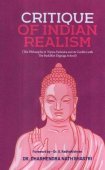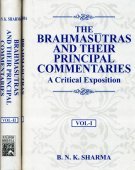Vacaspati-mishra, Vācaspati-miśra, Vācaspatimiśra: 9 definitions
Introduction:
Vacaspati-mishra means something in Hinduism, Sanskrit. If you want to know the exact meaning, history, etymology or English translation of this term then check out the descriptions on this page. Add your comment or reference to a book if you want to contribute to this summary article.
The Sanskrit terms Vācaspati-miśra and Vācaspatimiśra can be transliterated into English as Vacaspati-misra or Vacaspati-mishra or Vacaspatimisra or Vacaspatimishra, using the IAST transliteration scheme (?).
Alternative spellings of this word include Vachaspatimishra.
In Hinduism
Vedanta (school of philosophy)
Source: Hindupedia: Later AdvaitinsVācaspati Miśra, c. 10th century CE, was a gṛhastha scholar from the Mithilā region in modern Bihar state (bordering Nepal). He was knowledgeable in several disciplines connected to the Dharma and is traditionally hailed as a sarva-tantra-svatantra.
The uniqueness of Vācaspati Miśra was his ability to write on almost every darśana with the perspective of an insider. This is perhaps unparalleled in the history of the Dharma. Perhaps his most well-known work is the Bhāmatī, an exposition of Adi Shankaracharya's Brahmasūtra Bhāṣya.

Vedanta (वेदान्त, vedānta) refers to a school of orthodox Hindu philosophy (astika), drawing its subject-matter from the Upanishads. There are a number of sub-schools of Vedanta, however all of them expound on the basic teaching of the ultimate reality (brahman) and liberation (moksha) of the individual soul (atman).
Nyaya (school of philosophy)
Source: Shodhganga: A study of Nyāya-vaiśeṣika categoriesVācaspatimiśra (वाचस्पतिमिश्र).—Towards the first half of the ninth century, Vācaspati Miśra tried to re-establish the Nyāya doctrines propounded by Gautama, Vātsyāyana, and Uddyotakara. He wrote Nyāyavārtikatātparyatīkā. Vācaspati was a versatile, genius and prolific writer. He wrote commentaries on the works of other philosophical schools like Sāṃkhya, Vedanta and Mīmāṃṣā. In his work, Vācaspati has established the supremacy of Nyāya on other systems by refuting the opposite views. Vācaspati does not always followed Vātsyāyana or Uddyotakara for interpreting different Sūtras of Nyāyasūtra.

Nyaya (न्याय, nyaya) refers to a school of Hindu philosophy (astika), drawing its subject-matter from the Upanishads. The Nyaya philosophy is known for its theories on logic, methodology and epistemology, however, it is closely related with Vaisheshika in terms of metaphysics.
General definition (in Hinduism)
Source: Wisdom Library: HinduismVācaspatimiśra (fl. 976-1000); Author of the Tattvabindu, a Sanskrit work on the Mīmāṃsā school in Hindu philosophy.
Source: The Free Library: Vacaspatimisra’s TattvasamiksaVacaspatimisra, a medieval polymath of the tenth century, is renowned for a number of important works: commentaries written on core traditions of Brahmanic philosophy (Mimamsa, Vedanta, Samkhya, Yoga, Nyaya), a list of Nyayasutras (the Nydyasucinibandha), and an independent treatise, the Tattvabindu. The latter reviews doctrinal ramifications of the Vaiyakarana theory of sphota. The idea that Vacaspati would also have written a commentary on Mandanamis'ra's Brahmasiddhi was contingent on the occasional references made by Vacaspati himself elsewhere in his works and on a single mention in Anandabodha's Pramdnamala. It was not until 1994 that a fragmentary manuscript of this commentary (Tattvasamiksa) was discovered by Diwakar Acharya in the National Archives in Kathmandu. Despite the fact that the Tattvasamiksa does not seem to have exercised any noticeable influence comparable to other works of Vacaspati--it appears on the contrary to have been neglected--there is no question about its value for historical research. Not only is it by far the earliest commentary on Mandanamisra's Brahmasiddhi, but it also represents Vacaspati's first systematic examination of a structured Vedantic edifice
Source: UW-Madison Libraries: Vācaspatimiśra’s TattvasamīkṣāVācaspatimiśra is the author of the Sanskrit work called Tattvasamīkṣā, which is the earliest commentary on the Brahmasiddhi.
Source: Library of Congress Name Authority File: Vācaspatimiśra1) Vācaspatimiśra (976-1000). Author of the Tattvakaumudī and the Bhāmatī. He was a disciple of Mārtaṇḍatilakasvāmin. He is also known as Bachaspati Misra or Vācaspati Miśra.
2) Vācaspatimiśra (1420-1490). Author of the Pitṛbhaktitaraṅgiṇī and the Nyāyatattvāloka. He is also known as Vācaspati Miśra II or Mahāmahopādhyāyasanmiśravācaspatikṛtā or Vācaspatimiśra of Mithila or Miśravācaspati.
Vācaspati Miśra (900–980 CE) was an Indian philosopher who founded one of the main Advaita Vedanta schools, the Bhāmatī school (named after his commentary on Śankara's Brahma-sūtra-bhāṣya), and whose work was an important forerunner of the Navya-Nyāya system of thought.
He wrote commentaries on the main works of all the major Hindu schools of thought at the time, as well as one non-commentary, Tattvabindu. In Tattvabindu, Vācaspati examines four competing theories of linguistic meaning:
- Mandana Misra's sphoṭavāda,
- the Nyāya theory
- the similar Mīmāmsā theory
- the Prābhākara Mīmāmsā theory, anvitābhidhānavāda.
After examining each of these theories, Vācaspati presents his own theory, abhihitānvayavāda, according to which understanding of the meaning of a whole sentence is reached by inferring it, in a separate act of lakṣanā or implication, from the individual meanings of the constituent words.
Primary texts:
- Bhāmatī (on Śankara's Brahmasūtrabhāsya)
-
Tattvabindu
- Tātparyaţīkā (on Uddyotakāra's Nyāyavārttika)
-
Nyāyasūcīnibandha
- Tattvakaumudī (on Īśvarakrishna's Sāmkhyakārikās)
- Tattvavaiśāradī (on Patañjali's Yogasūtras and Bhāsya)
- Nyāyakanikā (on Maṇḍana Miśra's Vidhidviveka)
Languages of India and abroad
Sanskrit dictionary
Source: Cologne Digital Sanskrit Dictionaries: Aufrecht Catalogus Catalogorum1) Vācaspatimiśra (वाचस्पतिमिश्र) as mentioned in Aufrecht’s Catalogus Catalogorum:—of Mithila: Ācāracintāmaṇi. Kṛtyamahārṇava. Tīrthacintāmaṇi. Dvaitanirṇaya, written by order of Jayā, wife of Bhairava, mother of Puruṣottamadeva. Nīticintāmaṇi. Quoted in Vivādacintāmaṇi. Pitṛbhaktitaraṅgiṇī. Prāyaścittacintāmaṇi. Vivādacintāmaṇi. Vyavahāracintāmaṇi. Śuddhicintāmaṇi. Śūdrācāracintāmaṇi. Śrāddhacintāmaṇi. Gayāyātrā. Np. I, 86. Candanadhenudāna. L. 3154. Tithinirṇaya. L. 1839. Śabdanirṇaya. Quoted Oxf. 274^a. Śuddhiprabhā. Np. I, 86.
2) Vācaspatimiśra (वाचस्पतिमिश्र):—Kāvyaprakāśaṭīkā. Quoted twice in Caṇḍīdāsa’s commentary.
3) Vācaspatimiśra (वाचस्पतिमिश्र):—pupil of Mārtaṇḍatilakasvāmin. He is quoted by Sāyaṇa in Sarvadarśanasaṃgraha, Vardhamāna in Nyāyakusumāñjaliprakāśa, by Śaṅkaramiśra in Vaiśeṣikasūtropaskāra, by Sadānanda in Advaitabrahmasiddhi, and others: Tattvabindu, vedānta. Tattvaśāradī, yoga. Tattvasamīkṣā Brahmasiddhiṭīkā. Nyāyakaṇikā Vidhivivekaṭīkā mīm. Nyāyatattvāvalokā. Nyāyaratnaṭīkā. Nyāyavārttikatātparyaṭīkā. Brahmatattvasaṃhitoddīpinī. Bhāmatī or Śārīrakabhāṣyavibhāga. Yuktidipikā, sāṃkhya. Yogasūtrabhāṣyavyākhyā. Vedāntatattvakaumudī. Sāṃkhyatattvakaumudī. Vācaspatya, vedānta. Oudh. X, 20. Oppert. 826. 1566. 3207. 3353. 3478. 3543. 4248. 4346. 4715. 4789. 4886. 6661. Ii, 1157. 1540. 3069. 3935. 4350. 4919. 5412. 6006. 7155. 7239. 7911. 8585. 8686. 8774. 8941. 9203. 9267. 9321. 9365. 9508. 9652. 9793. 9983. Rice. 170.
4) Vācaspatimiśra (वाचस्पतिमिश्र):—(?), father of Lakṣmīdāsa:
—[commentary] on Bhāskara’s Siddhāntaśiromaṇi. Perhaps, as often happens, the father has been put in place of his son.
5) Vācaspatimiśra (वाचस्पतिमिश्र):—of Mithilā: Gayāprayoga. Śuddhinirṇaya (1360 ?). L. 3308.
6) Vācaspatimiśra (वाचस्पतिमिश्र):—the philosopher is quoted by Gaṅgeśa in Īśvarānumāna p. 81.
—Read Nyāyatattvāloka.
Vācaspati miśra (वाचस्पति मिश्र) as mentioned in Aufrecht’s Catalogus Catalogorum:—Candanadhenudānavidhi.
--- OR ---
Vācaspati miśra (वाचस्पति मिश्र):—wrote the Vyavahāracintāmaṇi at the court of Harinārāyaṇa, son of Hṛdayanārāyaṇa, grandson of Darpanārāyaṇa. Cs 2, 137.
--- OR ---
Vācaspati miśra (वाचस्पति मिश्र):—of Mithilā: Khaṇḍakhaṇḍanakhādyoddhāra. Nyāyasūtroddhāra.
Sanskrit, also spelled संस्कृतम् (saṃskṛtam), is an ancient language of India commonly seen as the grandmother of the Indo-European language family (even English!). Closely allied with Prakrit and Pali, Sanskrit is more exhaustive in both grammar and terms and has the most extensive collection of literature in the world, greatly surpassing its sister-languages Greek and Latin.
See also (Relevant definitions)
Partial matches: Mishra, Vacaspati.
Query error!
Full-text (+108): Bhamati, Tirthacintamani, Krityakalpalata, Martandatilakasvamin, Vyavaharacintamani, Tattvasamiksha, Varttikatatparyatika, Vivadacintamani, Pitribhaktitarangini, Bhamatikara, Shraddhacintamani, Gayaprayoga, Nriga, Samkhyatattvakaumudi, Krityacintamani, Udayakara, Udayanacarya, Nyayasutraddhara, Agama, Tattvabindu.
Relevant text
Search found 69 books and stories containing Vacaspati-mishra, Vacaspati-misra, Vācaspati-miśra, Vacaspatimishra, Vācaspatimiśra, Vacaspatimisra; (plurals include: mishras, misras, miśras, Vacaspatimishras, Vācaspatimiśras, Vacaspatimisras). You can also click to the full overview containing English textual excerpts. Below are direct links for the most relevant articles:
Contribution of Vachaspati-Mishra to Samkhya System (by Sasikumar. B)
Chapter 2 - Vācaspati Miśra—His life, date and works (introduction)
Chapter 2.1 - Vācaspati Miśra—Works on Nyāya-Vaiśeṣika
Nyaya-Vaisheshika (critical and historical study) (by Aruna Rani)
4. Authors of Nyaya (d): Vacaspati Mishra < [Chapter 2 - Historical Study of Nyaya system]
Appendix A - Detailed list of the Authors of old Nyaya
Appendix C - Detailed list of Commentaries on Tattva Chintamani
The concept of Sharira as Prameya (by Elizabeth T. Jones)
Yoga-sutras (with Vyasa and Vachaspati Mishra) (by Rama Prasada)
Sūtra 4.34 < [Book 4 - Absolute Independence (Kaivalya)]
Sūtra 2.37 < [Book 2 - Practice (Sādhana)]
Sūtra 3.39 < [Book 3 - Attainment (Vibhūti or Siddhi)]
Tattvabindu of Vachaspati Mishra (study) (by Kishor Deka)
Part 3.1 - Date of Vācaspati Miśra < [Chapter 1 - Introduction]
Part 3.3 - Works of Vācaspati Miśra < [Chapter 1 - Introduction]
A comparative study between Buddhism and Nyaya (by Roberta Pamio)
2.4. Perception according to Vācaspati Miśra < [Chapter 4 - The Nyāya Theory of Perception]
1. Nyāya: A Brief Introduction < [Chapter 4 - The Nyāya Theory of Perception]
2.1. Perception according to Gautama < [Chapter 4 - The Nyāya Theory of Perception]
Related products


